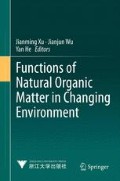Abstract
Northern peatlands store vast amounts of carbon. Although peatlands are at present net carbon sinks, they are also an important source for the greenhouse gases CO2 and CH4, and there is some concern that they may become carbon sources as global temperatures rise. In this work, we used Fourier-transform ion cyclotron resonance mass spectrometry (FT-ICR MS), PARAFAC modeling of excitation–emission fluorescence spectroscopy (EEMS), and specific UV absorbance (SUVA254) to investigate the chemical quality and composition of DOM in porewaters collected from different bog and fen systems in northern Minnesota, USA. Four terrestrial humic-like components and one non-humic-like component were identified by EEM-PARAFAC, and their dynamics were evaluated based on their distribution with depth as well across different sites. We found an abundance of a microbial humic-like component in fen porewater DOM. This component was not as abundant in bog porewaters. SUVA, determined at 254 nm, was strongly correlated with lower aromaticity in deep fen samples relative to deep bog samples as determined by 1H-NMR. Aromatic and carbohydrate components represented up to 70% of deep bog DOM but comprised a much smaller proportion of deep fen DOM, which was dominated by functionalized and non-functionalized aliphatics. Molecular formula data determined by FT-ICR mass spectrometry were consistent with results from optical and NMR spectroscopy experiments and showed that compounds with low O/C and high H/C were generated with depth in the fen. Such compounds were absent in both surface fen and in surface and deep bog samples, respectively, providing further evidence of qualitative and quantitative differences in the evolution of DOM in fens and bogs. These differences in reactivity suggest that bogs and fens will behave differently in response to global warming, with more CO2 and CH4 released from fens compared to bogs.
Access this chapter
Tax calculation will be finalised at checkout
Purchases are for personal use only
References
Chanton, J.P., P.H. Glaser, L.S. Chasar, D.J. Burdige, M.E. Hines, D.I. Siegel, L.B. Tremblay, and W.T. Cooper. 2008. Radiocarbon evidence for the importance of surface vegetation on fermentation and methanogenesis in contrasting types of boreal peatlands. Global Biogeochemical Cycles. 22(4), GB4022, doi:10.1029/2008GB003274.
Cory, R.M., and D.M. McKnight. 2005. Fluorescence spectroscopy reveals ubiquitous presence of oxidized and reduced quinones in dissolved organic matter. Environmental Science and Technology 39: 8142–8149.
D’Andrilli, J., J.P. Chanton, P.H. Glaser, and W.T. Cooper. 2010. Characterization of dissolved organic matter in northern peatland soil porewaters by ultra high resolution mass spectrometry. Organic Geochemistry 41: 791–799.
Author information
Authors and Affiliations
Corresponding author
Editor information
Editors and Affiliations
Rights and permissions
Copyright information
© 2013 Zhejiang University Press and Springer Science+Business Media Dordrecht
About this paper
Cite this paper
Cooper, W.T., Tfaily, M.M., Corbet, J.E., Chanton, J.P. (2013). Correlating Bulk Optical Spectroscopy and Ultrahigh-Resolution Mass Spectrometry to Determine the Molecular Composition of Dissolved Organic Matter in Northern Peatlands. In: Xu, J., Wu, J., He, Y. (eds) Functions of Natural Organic Matter in Changing Environment. Springer, Dordrecht. https://doi.org/10.1007/978-94-007-5634-2_4
Download citation
DOI: https://doi.org/10.1007/978-94-007-5634-2_4
Published:
Publisher Name: Springer, Dordrecht
Print ISBN: 978-94-007-5633-5
Online ISBN: 978-94-007-5634-2
eBook Packages: Earth and Environmental ScienceEarth and Environmental Science (R0)

